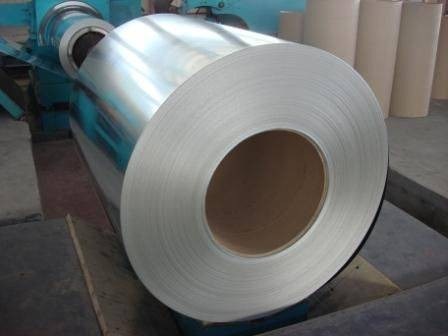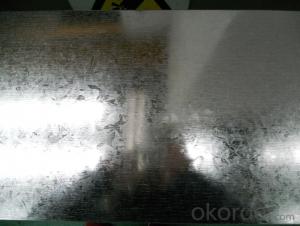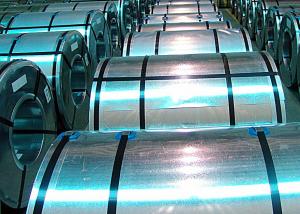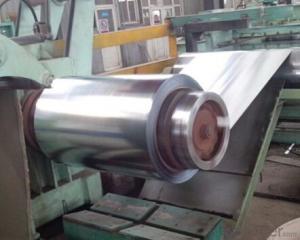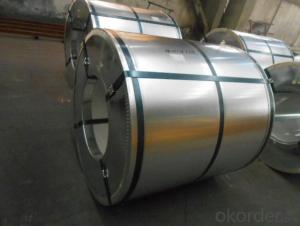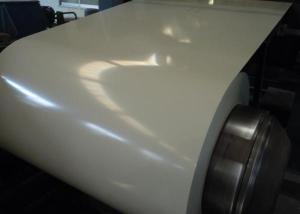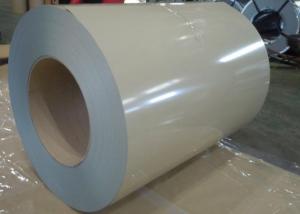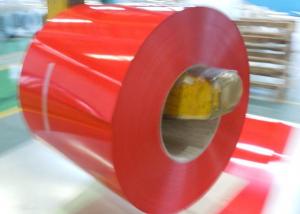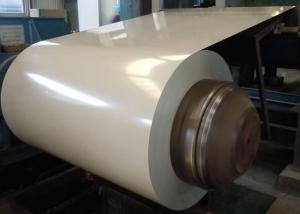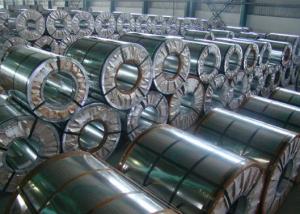Hot Dipped Galvanized Steel Coil
- Loading Port:
- China Main Port
- Payment Terms:
- TT OR LC
- Min Order Qty:
- -
- Supply Capability:
- -
OKorder Service Pledge
Quality Product, Order Online Tracking, Timely Delivery
OKorder Financial Service
Credit Rating, Credit Services, Credit Purchasing
You Might Also Like
HDG Coils DX51D+Z275-MA-C, unoiled, ID 508 / 610 mm, CW biggest
zero spangle, , Chrom 6 or Chrom 3, acc. to EN 10346/10143,
0,40 ( 0,39-0,43) x 1250 mm
0,45 ( 0,43-0,475) x 1250 mm
0,50 ( 0,45-0,50) x 1250 mm
0,60 ( 0,55-0,60) x 1250 mm
0,75 ( 0,73-0,78) x 1250 mm
- Q: Any details about JinSong Ferritic Stainless Steel?
- JinSong SUS420J2 stainless-metallic/ X30Cr13 has larger intensity, hardness and hardenability than 12Cr13 metallic and 20Cr13 metallic after quenching. It has much less corrosion resistance to dilute nitric acid and vulnerable organic and organic acid than 12Cr13 metallic and 20Cr13 metallic in room temperature. you will get extra strategies on its good website**
- Q: Steel seems to be much less expensive. What is the reason why? I've heard steel will ruin a barrel after time....is that true? But with the price difference maybe it don't matter? Is steel reliable? What are the negatives about steel I should know before buying?
- I guess you dont get out much or read the news. Brass - is mostly copper. And ever since the earthquake that decimated the west coast of South America 3 or 4 years ago and crippled the biggest copper producing area in the world - anythng made with copper - wire, buss bars, brass items etc, the cost has gone up 5x and not really gone back to what they were. The steel - is in the case, not the bullet. So, your worries about ruining the barrel are unfounded. The only drawback to steel case ammo - they are coated with a lacquor to prevent rust - is when you go burn off 3 or more mags in quick secession and then leave a live one in the chamber. The quick firing will heat up the barrel - enough to melt the lacquor. Leave a live round in it - it wont come out without firing. Onced this happens - excellent chance all the next rounds will jam until you clean the chamber with mineral spirits or other solvent and a brass brush. Like all things in life - when you use the generic product in 'moderation' things work ok. The only time you will be unhappy to have bought steel case ammo - is when you decide to reload. You cant handload steel - only brass does this. And smart people who are preppers and do not reload but rely on a 5.56mm rifle for protection - save thier brass. Because some day their might be an ammo shortage - I know, it's a stretch and will never happen - and having that reloadable brass means they can make more. You put 2 or 3 pounds of 4198 powder and one brick of small rifle primers in a cool dry place - this would be an even smarter thing. And a 1K box or two of Armscor 62gr fmj with the brass gives you an A in my book for being prepared. Much easier to store a few cans of powder than several thouand rounds of ammo. Toss that brass and projectiles in the garage or under the house.
- Q: How do steel coils contribute to the renewable energy sector?
- Steel coils contribute to the renewable energy sector by playing a crucial role in the manufacturing of wind turbines and solar panels. These coils are used to produce the structural components of wind turbine towers and solar panel support structures. Additionally, steel coils are also utilized in the construction of transmission lines and grid infrastructure for renewable energy projects, ensuring efficient distribution of electricity generated from renewable sources.
- Q: What are the different grades of steel used for making coils?
- When making coils, various grades of steel are commonly utilized, depending on specific requirements and applications. Some frequently employed grades are: 1. Mild steel, also referred to as low carbon steel, is often employed for coil production due to its favorable characteristics of formability, weldability, and machinability. It is suitable for diverse applications where strength and durability are not the primary concerns. 2. High carbon steel, which contains elevated carbon levels, offers increased strength and hardness. This grade is commonly used for coils that require high strength and resistance to wear, such as springs and automotive components. 3. Stainless steel, characterized by a high chromium content, exhibits excellent corrosion resistance. Coils made from stainless steel are commonly utilized in applications where resistance to rust and staining is critical, such as kitchen appliances, automotive trim, and medical equipment. 4. Galvanized steel, coated with a layer of zinc, provides exceptional corrosion resistance. Galvanized steel coils find common use in outdoor applications that involve exposure to moisture and other elements, including roofing, fencing, and HVAC ductwork. 5. Electrical steel, specifically designed for electrical applications like transformers, motors, and generators, possesses low impurity levels and is optimized for high magnetic permeability and low core loss. 6. Advanced high-strength steel (AHSS), engineered to offer exceptional strength while maintaining good formability, is frequently employed in the automotive industry. AHSS coils contribute to lightweighting vehicles while ensuring structural integrity and crashworthiness. These examples represent only a fraction of the steel grades employed in coil manufacturing. The choice of a specific grade depends on factors such as the intended application, desired properties, and cost considerations.
- Q: How are steel coils labeled for identification?
- Steel coils are typically labeled for identification using a combination of unique alphanumeric codes, barcodes, or labels that include important information such as the coil's dimensions, weight, grade, production date, and supplier details.
- Q: I would like to buy a new cold steel recon 1 folding knife. My concern is the knife is made in Taiwan, will the quality of blade/overall make is lower quality compare with those made in US/JAPAN? The plan is use as an EDC, any good suggestion with similar style? Most important to me is reliability, 2)sharpness, 3) maintance than 4)cost. Anyone can point me into right direction? Please share, Thanks in advance.
- Cold okorder /
- Q: Is boron steel or carbon steel a harder metal? Which one is more flexible?
- Boron is classified as a Metalloid element and is located in Groups 13, 14,15, 16 and 17 of the Periodic Table. An element classified as a Metalloid has properties of both metals and non-metals. Some are semi-conductors and can carry an electrical charge making them useful in calculators and computers.
- Q: How are steel coils used in the production of steel clamps?
- Steel coils are used in the production of steel clamps as they serve as the main raw material for creating the clamps. The steel coils are first processed and transformed into the desired shape and size through cutting, bending, and shaping processes. These coils are then formed into the clamp's body, providing the necessary strength and durability. Overall, steel coils play a crucial role in manufacturing steel clamps by providing the essential material for their construction.
- Q: What industries use steel coils?
- Several industries use steel coils, including automotive, construction, energy, manufacturing, and transportation.
- Q: How are steel coils used in the manufacturing of pressure vessels?
- Steel coils are used in the manufacturing of pressure vessels as they provide a strong and durable material for constructing the vessel's shell. The coils are typically rolled and welded to form the cylindrical shape of the pressure vessel, ensuring high structural integrity and the ability to withstand high pressure.
Send your message to us
Hot Dipped Galvanized Steel Coil
- Loading Port:
- China Main Port
- Payment Terms:
- TT OR LC
- Min Order Qty:
- -
- Supply Capability:
- -
OKorder Service Pledge
Quality Product, Order Online Tracking, Timely Delivery
OKorder Financial Service
Credit Rating, Credit Services, Credit Purchasing
Similar products
Hot products
Hot Searches
Related keywords




